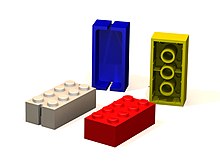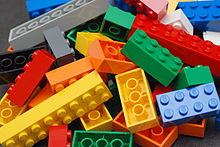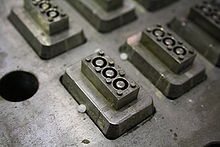Terminal block
Clamping blocks are modular construction elements made of plastic that can be positively assembled . The basic components are cuboid, cylindrical nubbed on the top in a grid dimension, hollow-bodied on the underside and smooth on the sides. The structured top side interacts with the correspondingly negative underside of other terminal blocks through friction and a form fit , so that complex designs can be plugged in.
properties
According to the systematics of game science , terminal blocks belong to the game genre of construction games . The distinguishing features of terminal blocks are:
- Modularity : According to the modular principle , the whole can be divided into parts and reassembled along defined points.
- Variability: Seven 4 × 2 stones of the same color can be combined in over 85 billion possibilities.
- Recombinability: stones can always be arranged differently to one another.
Desirable properties are:
- Fit : Tolerances of a few micrometers prevent jamming, steps or noticeable gaps between the stones.
- Elasticity : By deforming the holding tubes inside the stones, a permanent clamping or adhesive effect is achieved. The size difference between studs and tubes must be compensated for elastically.
- Shape, color and thermal stability : Despite the mechanical stress on the stones, no plastic deformation or breakage due to deformation or impact should occur, neither function nor appearance should be impaired.
- Chemical stability : high resistance to weather conditions, natural ultraviolet and ionizing radiation
- Wear resistance despite reversibility: Terminal connections should be mechanically residue to separate, for as little abrasion .
The knobs of the clamping blocks initially hold in the other component through a frictional connection - it prevents them from simply slipping out of the other component. In relation to clamping blocks, the force to pull a knob out of its receptacle is colloquially known as the “clamping force”. Components from different manufacturers differ significantly in this regard.
Above all, the form fit is effective across the nub.
Demarcation
Compared to ceramic or wooden kits, constructions can be created that can also be accelerated against gravity. Compared to metal construction kits , terminal blocks have only a weak bond, since they do not require a connector; however, the cohesiveness can be increased by interlocking cross connections. Metal construction kits are usually more space-forming.
material
Terminal blocks are made of thermoplastic plastic in the injection molding process made. The material of the clamping blocks must be elastic in order to compensate for the size difference between the knobs and the recess and to generate a permanent clamping effect, while remaining dimensionally stable and break-proof even with multiple disassembly / assembly and tensile / compressive loads. The surfaces should be smooth but easy to grip and have tolerances of just a few micrometers , since the top and bottom of the terminal blocks serve as a plug-in socket for one another.
Example Lego
Lego initially used the material cellulose acetate (CA), an acetate of cellulose . Lego blocks have been made from the plastic acrylonitrile butadiene styrene copolymer (ABS) since 1963 . Transparent components are made of polycarbonate ("Makrolon") and axles are made of polyamide (PA) because of their higher torsional rigidity . ABS has a low specific weight with a density of 1.03 to 1.07 g · cm −3 . Thanks to its good impact resistance, it is break-proof , and a surface hardness of 50–60 Shore makes it scratch-resistant. The material is resistant to aqueous chemicals, but not resistant to solvents such as acetone .
The plastic can be heated up to a temperature of 80 ° C and has good mechanical and acoustic damping properties . The amorphous thermoplastics used have a matt, glossy finish and different colors can be produced.
history
In 1934, the Rubber Specialties Company started producing their rubber picture-o-brik in the United States . From 1935 to 1976, the Premo Rubber Company manufactured the MiniBrix . The system consisted of brown rubber stones with a basic grid size of 1 × ½ × ⅜ inch. From 1939 onwards, the Halsam Products company manufactured its American Bricks from pressed wood.
The ELGO Plastic Company started producing terminal blocks under the name Elgo American Plastic Bricks from 1946 . In 1949, the Danish company Lego began industrial production of its Automatic Binding Bricks , which, like its predecessors, were hollow on the inside and therefore only had a very low adhesive effect. The bricks are an almost identical copy of the self-locking building bricks published in 1947 by the English brand Kiddicraft by the toy developer Hilary Page . In the 1997 publication Developing a Product , Lego explicitly refers to the origin of the terminal block:
Automatic binding bricks […] were inspired by a couple of British plastic building bricks by the Kiddicraft company and sold only in Britain. […] We modified the design of the brick […]. The modifications […] included straightening round corners and converting inches to cm and mm, which altered the size by approx. 0.1 mm in relation to the Kiddicraft brick. The studs on the bricks were also flattened in top.
“The Automatic Binding Bricks [...] were inspired by a few plastic bricks from the British Kiddicraft company , which only sold in the UK. […] We have changed the design of the module […]. The modifications […] included making the round corners square and converting inches to centimeters and millimeters, which changed the size by approx. 0.1 mm compared to the Kiddicraft stone. The knobs on the blocks have been flattened at the top. "
Possible combinations
Terminal blocks can be combined with one another in many ways. Two 4 × 2 stones of the same color can be arranged in 24 ways, with three this is already 1560. With only seven 4 × 2 stones of the same color, the number of combinations rises to over 85 billion, as a study by the Mathematical Faculty of Aarhus University shows.
|
Number of 4 × 2 stones of the same color |
resulting possible combinations |
| 1 | 1 |
| 2 | 24 |
| 3 | 1,560 |
| 4th | 119,580 |
| 5 | 10.116.403 |
| 6th | 915.103.765 |
| 7th | 85,747,377,755 |
Manufacturer
The construction toys are mostly sold in kits with assembly instructions , less often as single-origin bulk goods . In addition to the main model, instructions for an alternative model ("B-model") are occasionally offered. Standardized terminal blocks are produced in different shapes, sizes and systems by different manufacturers around the world, with the majority of manufacturers orienting themselves on the construction dimensions of the market leader Lego , a grid dimension of 8 × 8 mm in order to keep their connector systems compatible. Every manufacturer produces special modules, onto which clamping modules of the type described above can be placed or clamped.
Trademark protection litigation
Market leader Lego repeatedly sued competing terminal block manufacturers in court. The lawsuits were mostly unsuccessful, as the courts assessed the functional design of the base stone more as a question of patent than of trademark law , and all relevant Lego patents have expired. Lego itself copied its bricks in the late 1940s from an invention by British psychologist Hilary "Harry" Fisher Page.
Lego and Tyco Industries argued in US courts over Tyco's terminal blocks in the 1980s, with Tyco winning. On August 31, 1987, the US District Court ruled that Tyco could continue to produce Lego clone bricks with the product name Super Blocks , but ordered that Tyco should stop using the Lego brand and not advertise with "Lego, but only cheaper" . Lego obtained an injunction through Lego's Hong Kong lawsuit against Tyco Super Blocks , forcing Tyco to stop cloning post-1973 Lego blocks . Tyco was also sued by Lego in Austria, Italy and Canada.
The Canadian manufacturer Mega Bloks was sued because the use of the composite brick system of "studs and tubes" constituted a violation of the brands held by Lego. On 17 November 2005, confirmed Supreme Court of Canada the right of Mega Bloks to continue to sell the product in Canada. On November 12, 2008, the General Court of the European Union made a similar decision in the first instance. On September 14, 2010, the European Court of Justice ruled that the eight-knob design of the original Lego brick “only fulfills a technical function [and] cannot be registered as a trademark”.
The English company Best-Lock Construction Toys sued Lego in German courts in 2004 and 2009. In the latter case, the Federal Court of Justice rejected the Lego trademark protection for the shape of its bricks.
In 2002, Lego's Swiss subsidiary Interlego AG successfully sued Tianjin CoCo Toy Co. Ltd. for copyright infringement . An appeals court found that many CoCo sets violated the law. CoCo was ordered to stop manufacturing the illegal sets, publish a formal apology in the Beijing Daily and pay a small amount of compensation to Interlego . On appeal, the Beijing Supreme People's Court upheld the court's judgment.
In 2000, Lego registered a three-dimensional trademark for its minifigures, which Best Lock had duplicated in 1998. Best Lock sued in 2012 to revoke the trademark. On June 16, 2015, the European Court of Justice upheld the Lego figurine brand. Lego had filed its copyright claims in a US customs database in 2009, which led to the seizure of best-lock shipments from Asia. In October 2011, Lego filed a lawsuit against Best-Lock with the United States District Court in Hartford over the minifigure mark. Mega Bloks won a case in the EU Supreme Court in 2010 against the trademark registration of a red toy building block by Lego.
In 2002, Jon Capriola had the idea of a light brick called Laser Pegs , for which a patent was applied for in 2006 and finally granted in 2009. Lawrence Rosen of LaRose Industries was approached by Capriola to invest in the company at the American International Toy Fair in February 2011 . Instead, Rosen applied for an accelerated patent and was granted it in 2012. LaRose Industries' Cra-Z-Art division then began producing Lite Brix light blocks. In 2013, Capriola's company sued Rosen for patent infringement, while Rosen petitioned the United States Patent and Trademark Office to have his patent canceled . In 2014, Light Stax was introduced as a further LED light -compatible component.
In 2011, Lego sued the Guangdong Jumbo Grand Plastic Molding Industrial for counterfeit packaging from BanBao . The two companies reached an out-of-court settlement, with Guangdong agreeing to put up its own packaging and produce a new character called ToBees.
In 2016 Lego announced that it would take legal action against the Chinese manufacturer Guangdong Loongon , which produces the Lepin brand and is known for identical replicas of Lego models.
literature
- Basil Harley: Constructional Toys . Shire Publications Ltd, Buckinghamshire 1990, ISBN 978-0-7478-0081-1 , pp. 32 (English).
- Tobias Hammerl: LEGO: building blocks of a folkloric play culture research . Regensburg writings on folklore / comparative cultural studies, Volume 34, ISSN 2196-9558 . University of Regensburg , Buckinghamshire 2014, ISBN 978-3-8309-3249-9 ( google.de ).
- The didactic significance of LEGO . (PDF; 3.3 MB) Technical University Berlin , March 13, 2015.
- Pawel "Sariel" Kmiec: The "unofficial" LEGO Technic book: Creative building techniques for realistic models . dpunkt.verlag , 2017, ISBN 978-3-86490-433-2 , p. 428 .
Videos
- Bricks Before LEGO on YouTube . (Video; 8:02 min). January 30, 2016. (English)
- Thorsten Klahold: 25 Lego alternatives - legal and morally dubious! on YouTube October 17, 2018. (Video; 33:58 min).
- Henry Krasemann: How LEGO bricks are made. on YouTube January 21, 2018. (Video; 8:14 min).
Web links
- Wolfgang Lenders: Competition on the pimple market . In: Brand one . Edition 3/2008. ISSN 1438-9339 .
- Michael Schäfer: 60 years of Lego-Brick: A building block defies digitization . In: ComputerBase . January 28, 2018.
Individual evidence
- ↑ LEGO injection molding . In: kunststoff-magazin.de . (Video; 5:03 min)
- ↑ Reinhard Wolff: Where is the green block? In: The daily newspaper (taz). February 12, 2018, accessed March 2, 2019 .
- ↑ Antonia Bauer: This is how a Lego brick is made. In: Der Spiegel (online) . February 1, 2020, accessed August 16, 2020 .
- ↑ Thomas Portl: NanoHIPS as an impact-modified thermoplastic. (PDF; 14.7 MB) In: Technische Universität Darmstadt - Department of Chemistry. May 23, 2011, accessed February 21, 2019 .
- ↑ Lego, the toy of the century . In: Wissen.de .
- ↑ Katrin Morawitz: Acrylonitrile-Butadiene-Styrene (ABS). In: Lecture as part of the "Exercises in Lecturing with Demonstrations - Organic Chemistry", SS 2011. May 2, 2016, accessed on March 2, 2019 .
- ↑ a b Maaike Lauwaert: The Place of Play: Toys and Digital Cultures . Amsterdam University Press, Amsterdam 2009, ISBN 978-90-8964-080-2 , chapter 7. LEGO Toys: from Wooden Blocks to Plastic Bricks (p. 52), p. 159 (English, google.de ).
- ↑ Margaret Simpson: Minibrix construction toy. In: Museum of Applied Arts & Sciences. March 2008, accessed on August 16, 2020 .
- ↑ The History of Minibrix . In: minibrix.com . (English)
- ↑ Halsam . In: toyhistory.com . July 5, 2008. (English)
- ↑ Lego vs. Elgo . In: eurobricks.com . March 13, 2016.
- ↑ Chris Preovolos: The Lego brick turns 60: Here's a look back. In: Connecticut Post. February 2, 2018, Retrieved September 11, 2019 (American English).
- ↑ History of block toys before LEGO. In: Gigazine. February 3, 2016, accessed on September 11, 2019 .
- ↑ Martin Wolf: The Philosopher's Stone . In: Der Spiegel . No. 12 , 2014 ( online ).
- ↑ Sören Eilers: A LEGO Counting problem. Aarhus University , April 7, 2005, accessed June 9, 2019 .
- ↑ Julia Bonstein: Knob by knob . In: Der Spiegel . No. 51 , 2005 ( online ).
- ↑ a b Mara Lee: Blocking And Tackling: A Nasty LEGO Copyright Battle. In: Hartford Courant . January 29, 2012. Retrieved October 8, 2018 (American English).
- ↑ Gregory Seay: Lego locked in domestic copyright fight. In: Hartford Business Journal. January 30, 2012, Retrieved February 26, 2019 (American English).
- ^ Ian Austen: Building a Legal Case, Block by Block. In: The New York Times . February 2, 2005, Retrieved February 21, 2019 (American English).
- ^ Caroline E. Mayer: Lego, Tyco Each Declare Victory in Battle of the Bricks. In: Washington Post . September 1, 1987, Retrieved February 21, 2019 (American English).
- ↑ 2005 SCC 65 . CanLII. November 17, 2005. Retrieved March 9, 2015.
- ↑ Lego loses trademark ruling in EU. (No longer available online.) In: The New York Times . October 12, 2008, archived from the original on October 26, 2008 ; Retrieved February 19, 2019 (American English).
- ↑ CNS: Montreal's Mega Brands triumphant after Lego loses trademark challenge. (No longer available online.) In: The Gazette . September 15, 2010, archived from the original on September 19, 2010 ; Retrieved June 9, 2019 (American English).
- ↑ Dennis Breuer: Press release of the BGH No. 158/2009: Lego brick deleted as a trademark. In: Markenmagazin.de. April 19, 2012, accessed September 11, 2019 .
- ↑ Press release No. 147/04 of December 3, 2004 . Juris.bundesgerichtshof.de. December 3, 2004. Retrieved March 9, 2015.
- ↑ Lego defeats the Chinese pirates. In: BBC News . Retrieved January 21, 2003, accessed January 11, 2020 (UK English).
- ↑ Sarah Butler: Lego blocks legal bid to remove trademark protection for its mini-figures. In: The Guardian . June 16, 2015. Retrieved February 26, 2019 (UK English).
- ↑ AFP: EU court rules Lego figurines are protected trademark. In: The Telegraph . June 16, 2015. Retrieved June 9, 2019 (American English).
- ↑ Ashley Lagzial: Patent Fight Short Circuits 'Laser Peg' Toy Plan. In: CNBC . June 30, 2013. Retrieved January 11, 2020 (American English).
- ↑ New Hybrid range brings sound to Stax creations. In: Toy World Magazine. Alakat Publishing, September 14, 2018, accessed July 18, 2019 .
- ↑ Abe Sauer: China Watch: Banbao Blames Lego For Not Letting Banbao Copy Lego. In: Brandchannel. September 24, 2012, accessed January 11, 2020 .
- ^ Christian W .: Fierce copyright battle mars Lego's push in China. In: The Copenhagen Post. December 1, 2016, accessed July 18, 2019 .





